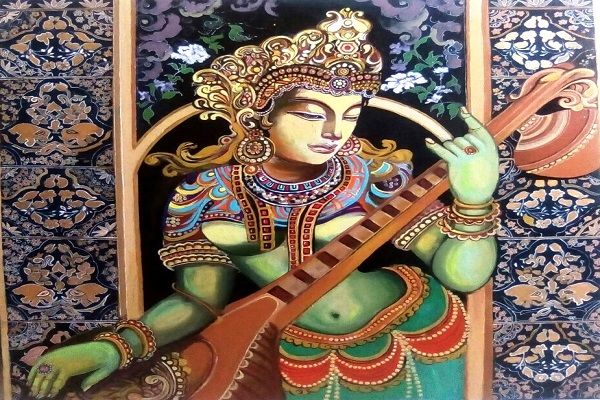
Welcome to the enchanting world of Saraswati paintings, where art meets spirituality and beauty knows no bounds. Saraswati paintings are a visual representation of the Hindu goddess Saraswati, the patroness of knowledge, music, art, and wisdom. These paintings capture the essence of Indian mythology, culture, and spirituality, and have been revered and cherished by generations of art lovers.
The roots of Saraswati paintings can be traced back to the ancient Indian civilization, where artists used to paint on rocks, caves, and temple walls to depict the divine and mythical figures of Hinduism. Over time, these paintings evolved into a distinct style, featuring intricate details, vibrant colors, and exquisite patterns. Today, Saraswati paintings are a popular genre of Indian art, celebrated for their intricate beauty and cultural significance.
Saraswati paintings hold a special place in Indian culture as they symbolize the pursuit of knowledge, creativity, and spirituality. In Hinduism, Saraswati is worshipped as the goddess of learning and wisdom, and her blessings are sought by students, scholars, artists, and musicians alike. Her iconography is often depicted in paintings with the lotus flower, the peacock, the veena, and the swan, which represent purity, beauty, creativity, and grace.
In this article, we will take a glimpse into an Indian art gallery and explore the beauty and richness of Saraswati paintings. Join us on this visual journey and immerse yourself in the world of Indian art and culture.
Saraswati Paintings in Indian Art Gallery
The Indian Art Gallery that we are visiting today is a spacious and well-lit space that showcases an impressive collection of Indian art. The gallery is adorned with elegant white walls that provide a perfect backdrop for the colorful paintings on display. The lighting in the gallery has been thoughtfully arranged to highlight the intricate details of each painting, making them come to life.
As we enter the gallery, we are greeted with an impressive collection of Saraswati paintings, each with its unique style, theme, and color scheme. The gallery features a diverse range of Saraswati paintings, from classical to contemporary, and from miniature to large-scale.
Some of the prominent types of Saraswati paintings on display include:
- Miniature Paintings: These are small, finely detailed paintings that require a high level of skill and precision. They usually depict the goddess Saraswati in a classical pose, surrounded by intricate floral patterns and motifs.
- Tanjore Paintings: These are a type of Indian painting that originates from the city of Tanjore in southern India. They are known for their vibrant colors, rich embellishments, and use of gold leaf. Tanjore paintings of Saraswati often feature her seated on a lotus, with her veena and peacock by her side.
- Contemporary Paintings: These are modern interpretations of Saraswati paintings that blend traditional motifs with contemporary themes and techniques. They often feature bold, abstract designs, and vibrant colors, making them a perfect fit for modern interiors.
Let us now take a closer look at some of the paintings in the gallery:
One of the most striking paintings on display is a large-scale Tanjore painting of Saraswati. The painting features the goddess seated on a lotus, with her veena in hand and her peacock by her side. The painting is embellished with gold leaf, intricate patterns, and vivid colors, making it a breathtaking sight to behold.
Another noteworthy painting is a contemporary interpretation of Saraswati, which features a vibrant, abstract design. The painting showcases Saraswati in a modern avatar, with bold brushstrokes and vivid colors that evoke a sense of energy and vitality.
Finally, we come across a delicate miniature painting of Saraswati. The painting is exquisitely detailed, with intricate patterns and motifs that highlight the goddess's grace and beauty. The use of soft colors and delicate brushstrokes adds to the painting's charm and elegance.
As we walk through the gallery, we are struck by the sheer diversity and beauty of Saraswati paintings on display. Each painting tells a unique story and captures a different aspect of Indian art and culture. It's truly a feast for the eyes and the soul.
Symbolism in Saraswati Paintings
Saraswati paintings are full of symbolism, and the goddess's physical features are rich in meaning. Saraswati is often depicted with four arms, which represent the four aspects of human personality - mind, intellect, ego, and consciousness. She is also shown wearing a white sari, which symbolizes purity, clarity, and truth. Her serene expression and graceful posture reflect her embodiment of wisdom and knowledge.
The objects depicted in Saraswati paintings are also full of significance. The veena, a musical instrument that Saraswati is often shown playing, represents the harmony between knowledge and art. The lotus flower, which is often seen in her hands or around her, symbolizes purity, spiritual enlightenment, and the unfolding of the soul. The peacock, her loyal companion, represents beauty, vibrancy, and pride.
The colors used in Saraswati paintings are carefully chosen to convey a deeper meaning. White, which is often used for Saraswati's clothing, represents purity, clarity, and truth. Yellow, which is the color of the sun, represents knowledge, learning, and enlightenment. Red, which is associated with passion and energy, symbolizes creativity, vitality, and dynamism. Blue, which is the color of the sky and the ocean, represents infinity, tranquility, and depth.
The use of these colors, combined with the intricate details and symbolism, make Saraswati paintings a feast for the eyes and the soul. They offer a glimpse into the rich cultural and spiritual heritage of India and serve as a reminder of the importance of wisdom, knowledge, and creativity in our lives.
Saraswati Paintings in Modern Culture
Saraswati paintings have had a significant influence on modern Indian art. Many contemporary artists draw inspiration from the traditional motifs and styles of Saraswati paintings, and incorporate them into their work. They offer a modern interpretation of this ancient art form, while still paying homage to its rich cultural heritage.
In recent years, Saraswati paintings have become increasingly popular in home decor. They add a touch of elegance and sophistication to any room and serve as a reminder of the importance of knowledge, creativity, and wisdom. Saraswati paintings are often hung in study rooms, libraries, and other areas dedicated to learning and knowledge.
Saraswati paintings have also gained popularity in the global market. They are highly valued for their intricate details, rich colors, and cultural significance. Many collectors and art enthusiasts around the world are drawn to Saraswati paintings and appreciate their beauty and spiritual meaning.
In conclusion, Saraswati paintings are not only a testament to India's rich artistic heritage but also serve as a source of inspiration and wisdom for modern society. Their popularity in modern culture is a testament to their timeless beauty and significance, and a reminder of the importance of creativity, knowledge, and wisdom in our lives.
Conclusion
Saraswati paintings are truly beautiful and meaningful works of art that offer a glimpse into India's rich cultural heritage. Their intricate details, rich colors, and symbolic meanings make them a feast for the eyes and the soul. Through these paintings, we can appreciate the importance of wisdom, knowledge, and creativity in our lives.
As we embrace modernity, it is important to remember the significance of preserving traditional art forms like Saraswati paintings. These paintings are a testament to India's cultural richness and diversity, and they serve as a reminder of the importance of preserving our artistic heritage for future generations.
I encourage readers to visit Indian art galleries, such as IndianArtIdeas.in, to appreciate the beauty of Saraswati paintings and other forms of traditional Indian art. These galleries offer a unique opportunity to immerse oneself in the rich cultural heritage of India and appreciate the beauty and significance of its art. By supporting these galleries and the artists they represent, we can help preserve and promote India's artistic legacy.





















